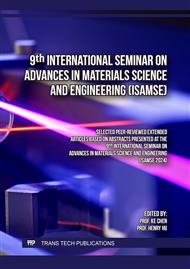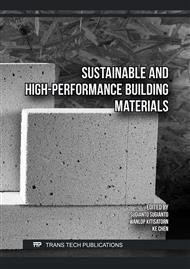[1]
Kong Yankui, Zhang Yujiao. Discussion on issues related to architectural structure reinforcement [J]. Building Materials and Decoration, 2017 (24): 2. DOI:CNKI: SUN.0.2017-24-023.
Google Scholar
[2]
Qiu Shunhua. Study on reinforcement and renovation technologies based on existing old buildings [J]. China High Technology, 2023(21):134-136.
Google Scholar
[3]
Xu S, Mu F, Wang J, et al. Experimental study on the interfacial bonding behaviors between sprayed UHTCC and concrete substrate [J]. Construction and Building Materials, 2019, 195: 638-649.
DOI: 10.1016/j.conbuildmat.2018.11.102
Google Scholar
[4]
Zhong Junfei, Wang Zonglin, Gao Qingfei. Chloride ion permeability resistance of PVA fiber reinforced cement-based composites [J]. Concrete, 2019(6):4. DOI: CNKI:SUN.0.2019-06-026.
Google Scholar
[5]
Zhang Yuanmiao, Yu Jiangtao, Lu Zhoudao, et al. Experimental study on seismic performance of ECC repaired shear walls [J]. Engineering Mechanics, 2015(1):9.
Google Scholar
[6]
Li V C. A simplified micromechanical model of compressive strength of fiber-reinforced cementitious composites [J]. Cement and Concrete Composites, 1992, 14(2): 131-141.
DOI: 10.1016/0958-9465(92)90006-h
Google Scholar
[7]
Maalej M, Quek S T, Ahmed S F U, et al. Review of potential structural applications of hybrid fiber Engineered Cementitious Composites [J]. Construction and Building Materials, 2012, 36: 216-227.
DOI: 10.1016/j.conbuildmat.2012.04.010
Google Scholar
[8]
Zhou Xiaoming. Study on the durability of PVA fiber reinforced cement-based composites [D]. Harbin Institute of Technology, [2024-06-14].
Google Scholar
[9]
Qian Guifeng, Gao Xiangbiao, Qian Chunxiang. Effects of PVA fibers on the mechanical properties of concrete [J]. Concrete and Cement Products, 2010(3):3.
Google Scholar
[10]
T/BECS 0001-2023, Technical Regulations for Masonry Structure Reinforcement with High Ductility Concrete [S].
Google Scholar
[11]
Gao Shuling, Xu Shilang. Experimental study on tensile characteristics of PVA fiber reinforced cement-based composites [J]. Journal of Dalian University of Technology, 2007, 47(2):233-239.
Google Scholar
[12]
Li Yan, Liu Zejun, Liang Xingwen. Uniaxial tensile characteristics of high-performance PVA fiber reinforced cement-based composites [J]. Engineering Mechanics, 2013, 30(1):322-330.
Google Scholar
[13]
Yu Baoying, Zhou Jianwei, Kong Yaning, et al. Influence of PVA fiber length on the mechanical properties of ultra-high toughness cement-based composites [J]. Bulletin of Silicate, 2020(011):039.
Google Scholar
[14]
Li J, Deng Z. Tensile behavior of hybrid fiber-reinforced ultra-high-performance concrete [J]. Frontiers in Materials, 2021, 8: 769579.
DOI: 10.3389/fmats.2021.769579
Google Scholar
[15]
Jiang Heping. Mesoscopic damage finite element numerical simulation and experimental study of ultra-high performance concrete [D]. Fuzhou University, 2020. DOI:10.27022/d.cnki.gfzhu. 2020.000066.
Google Scholar
[16]
JC/T2461-2018, Test methods for mechanical properties of high ductility fiber reinforced cementitious composites [S]. Beijing: China Building Materials Industry Publishing House, 2018.
Google Scholar



